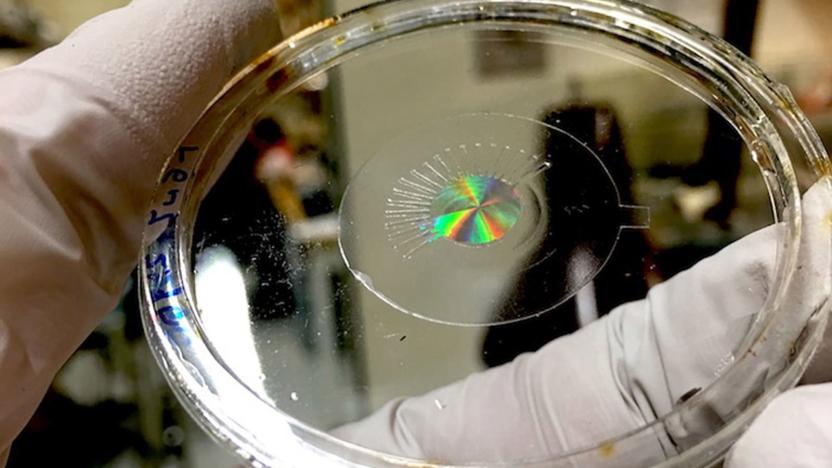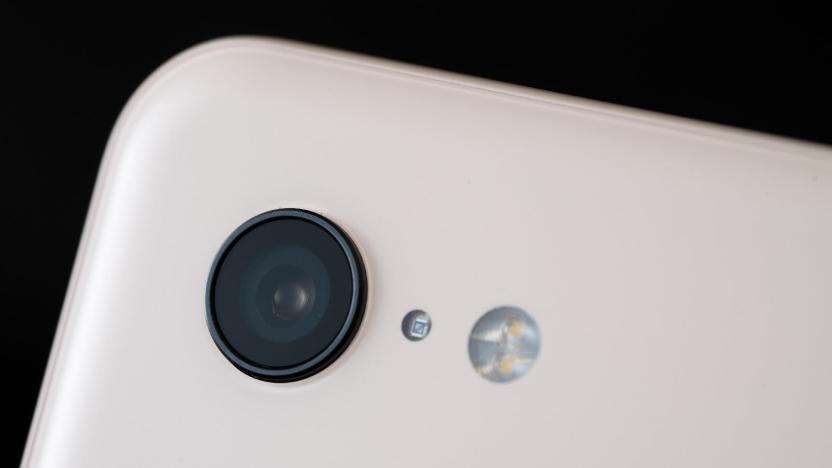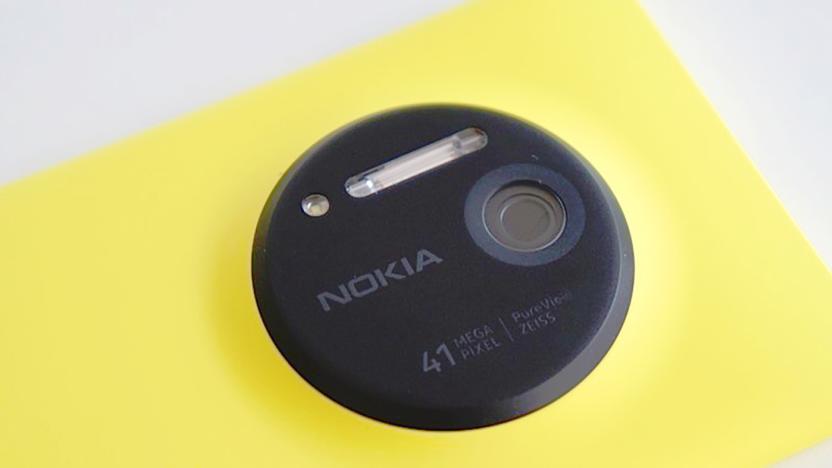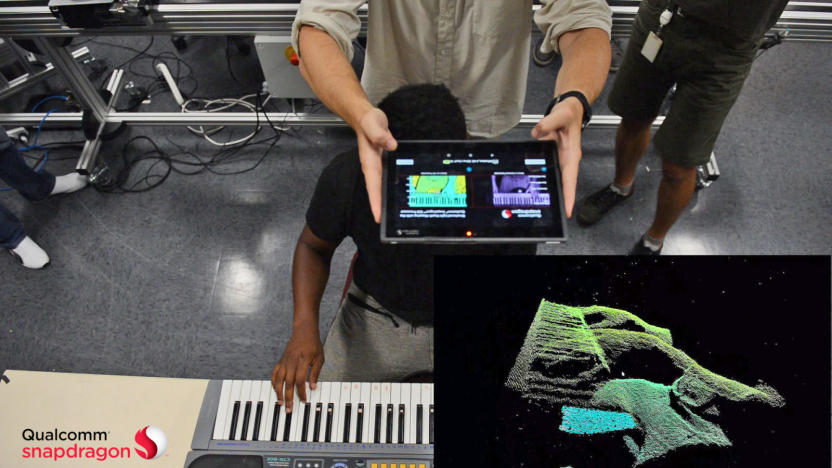SmartphoneCamera
Latest

Researchers create electronic lens that works better than the human eye
A new breakthrough could soon revolutionize the design of almost every optical instrument in use today, including cameras, eyeglasses and telescopes. Combining recent developments in artificial muscle and flat lens technologies, a team of researchers at the Harvard John A. Paulson School of Engineering and Applied Sciences (SEAS) have created a new lens that functions a lot like the human eye. Not only is the instrument capable of focusing in real-time thanks to an elastomer muscle, it features none of the bulk of a traditional spherical lens. It can even do some things the human eye can't, including adjusting for astigmatism and image shift, two variables that lead to blurry vision.

The Pixel 3 has 2018’s best smartphone camera
Let's be honest. We're a generation obsessed with taking and sharing photos. In recent years, our phone cameras have become so capable they've essentially killed point-and-shoots. This year, Huawei released a phone with three cameras on its rear, forcing us to wonder if we have officially gone too far with our sensor obsession. But companies like Apple and Google continue to prove that good software is a key part of a solid camera while Samsung's flagships remind us that there is room for innovation in mechanisms like dual aperture and dual-pixel autofocus. Ultimately, though, the best camera would deliver a mix of clever software with high-quality glass, and 2018's flagships did not disappoint.

A new Nokia PureView phone could be on the horizon
High-megapixel smartphone cameras are back in vogue, and now we might once again see the brand that started it all. Nokia smartphone maker HMD has reacquired the PureView brand from Microsoft, according to the European IP office EUIPO, and first spotted by Nokiamob. HMD builds all Nokia-branded smartphones under license, including the Nokia 1, 6 and 7 Plus, along with the flagship Nokia 8 Sirocco and retro 8110 Reloaded.

Qualcomm's new depth-sensing camera is surprisingly effective
Dual cameras are so passé. Qualcomm is getting ready to define the next generation of cameras for the Android ecosystem. It's adding three new camera modules to its Spectra Module Program, which lets device manufacturers select readymade parts for their products. The additions are an iris-authentication front-facing option, an Entry-Level Computer Vision setup and a Premium Computer Vision kit. The latter two carry out passive and active depth sensing, respectively, using Qualcomm's newly revamped image-signal-processing (ISP) architecture.

Samsung ISOCELL smartphone camera sensors promise better colors in low-light
Samsung's offering up spoilers at what we can expect from future Galaxy smartphones -- already. They will likely feature ISOCELL, the company's new CMOS imaging sensor. It adds "advanced pixel technology" that polices the absorption of electrons for improved color fidelity, even when lighting isn't ideal. The new sensor will head to new "premium" smartphones and tablets, with mass production scheduled to start in Q4 2013. Samsung's ISOCELL tech improves on current BSI (back-side illuminated) sensors by adding a "physical barrier between neighboring pixel". The science behind it means that more photons can be collected and that's what will improve image quality. This between-pixel crosstalk is apparently reduced by 30 percent, and increases the dynamic range of photos by up to 30 percent -- as you'll note from the washed-out petal tips in the sample above. Samsung explains that "market pressure" has meant it had to increase camera resolution and image quality, without increasing the size of the camera unit. This meant that pixels had to shrink, "while improving their performance at the same time". Interestingly, this sensor is specifically for 8-megapixel units, which could mean a drop down from the 13-megapixel camera seen in the Galaxy S 4. A full camera unit housing ISOCELL would also take up less space inside devices compared to previous imaging sensors, with a reduced height that sounds like it could be ideal for the company's future high-powered, even thinner smartphones.

Nikon feels the pressure from smartphones, says it needs to 'change the concept of cameras'
With slumping point-and-shoot camera sales and falling earnings, even a conservative company like Nikon can see the writing on the wall. President Makoto Kimura told Bloomberg that the number of people dropping compact shooters in favor of smartphones is "exploding" and that his company has created a new imaging business team to address the problem. He said that its task is "to create a product that will change the concept of cameras," adding that such a device will come to market in less than five years. Kimura didn't respond when asked if Nikon might build its own smartphone, though he said "(a new device) could be a non-camera consumer product." Whatever it turns out to be, given the current trend in smartphone sales and the fact that its imaging division nets 84 percent of Nikon's revenue, a little more diversification surely couldn't hurt.

New Toshiba camera sensor lets you refocus after the shot, plans 2013 launch in smartphones and tablets
Hoping for some after-the-fact focusing in your next smartphone camera? Well, you'll have to wait around a year, but Toshiba's planning exactly that with a new module that houses an array of 500,000 tiny lenses. Within a 1cm-thick unit, these lenses are layered in front of the camera sensor, which can capture slightly different images from each lens arrangement. Those picture can then be combined in a "complete" picture using Toshiba's own software. Apparently, the camera will also be able to measure the distance between objects in the shot -- similar to how 3D images are captured -- with the user then able to shift focus between close and distant detail, or even create images that are in-focus throughout. Toshiba says the module will also be able to capture video with a similar degree of focus management -- something that Lytro hasn't got around to just yet. The sensor is still a work in progress, but the manufacturer plans to commercialize the module before the end of 2013. Toshiba is looking to ally itself with multiple smartphone (and tablet) makers -- and here's hoping that it finds its way into a device outside of Japan. [Thanks Franck]

Sony announces new Exmor RS cameraphone sensor: upgraded signal processing, HDR video recording
That camera sensor in your smartphone is very likely to be a Sony-made module which means it's worth keeping an eye on the company's latest sensor developments. Your next phone could be packing one of its latest Exmor RS camera modules, a stacked CMOS image sensor that's currently being readied for future smartphones and tablets. At the moment, three components fall under the new RS label, with two eight-megapixel sensors (one with new camera signal processing tech) and a top-drawer 13-megapixel module. Alongside the new sensors, Sony's crafted new f/2.2 lenses alongside a refreshed auto-focus module and all of them will be capable of HDR video recording. The company's now working on improving sensor behavior, image quality and keeping it all tiny enough for that next pricey phone contract. The first products are expected to arrive in October, so we may not see it in Sony's very next tablet, but development could be done in time for next year's effort -- and help validate the manufacturer's imaging investment.

Insert Coin: Cardboard Robot brings craning, plucking and learning with a dash of whimsey (video)
In Insert Coin, we look at an exciting new tech project that requires funding before it can hit production. If you'd like to pitch a project, please send us a tip with "Insert Coin" as the subject line. Cardboard Robot has lowered it's crane claw boom on all the Kickstarter money business, and said "Hey, let's have a little fun here, too." It's a robotic arm kit consisting of four stepper motors, a controller, USB computer connection, and a structure made from corrugated cardboard with a claw or smartphone camera mount. While able to pick up small objects like socks and stuffed animals or crane a smartphone around, the fanciful bot's main function seems to be the fun of piecing it together, with its pliable surface also safer for working with kids. To that end, the mech's maker said that not only would it be easy to build, but the source code would be included for tweaking and with every $3k raised, one of the kits would be donated to a US school. So, if you want your own carton-y bot arm kit for learning and light plush toy duty (assembly required), the minimum pledge is $175 -- check the Kickstarter source to see how to pony up, or the video after the break.

Does BlackBerry 10's camera app get by with a little help from Scalado Rewind? (Update: Yes)
Impressed by the new camera tech on display in BB10? You're not alone. But did the folks at RIM have some help with the new "timeline lens" feature? Well, grab your salt shaker. If you recall, software that allows you to change the faces of those pictured via additional pre- and post-shot frames popped up in Scalado's Rewind last year. The ring UI that allows the user to navigate the extra frames from its border is quite similar to the functionality of BB10's editing feature. We've reached out to Scalado for further details on the matter and we're eager to hear its response. But until that happens, hit the video just past the break for a closer look at Rewind in action. Update: Our pals over at TechCrunch posted an official statement from RIM's Senior Manager of Public Relations Patti McKague on the matter. Our instincts were correct, as the two companies have been in cahoots over the BB10 camera app. Here's the full quote on the licensed tech: RIM has been working with Scalado on camera technology and has licensed some of the Scalado technology for the BlackBerry 10 platform. As shown during the BlackBerry World Keynote, RIM is planning a unique implementation of the technology on BlackBerry 10 to provide an incredible user experience, allowing for more customization by the user and enabling them to easily capture and share their perfect moments.

BlackBerry 10 camera app gets 'timeline lens,' bad photographers get a do-over
Thorsten Heins is on stage at BlackBerry World 2012 and has just unveiled the new BB10 camera app. It is designed to capture those "magic moments" you miss by not hitting that shutter quick enough. If you miss it by a couple of seconds, you can cycle back through the camera's cache with a circular "timeline" lens and take your pick from the previous seconds worth of frames. It's eerily reminiscent of technology used in the Nikon 1 series, although the implication here is that as soon as the camera app is loaded, it'll start recording frames for your ease of use.

Show off your smartphone photog skills with Sony Ericsson's vscreens
Have you been jonesin' to show off those Epic 4G Touch camera skills on a bit bigger screen? Sony Ericsson has you covered with vscreens, a website / app combo that gets your trip to Everest on your flatscreen to secure bragging rights. Once you install the app from the Android Market, point your internet browsing screen -- PC, Google TV and PS3 included -- to the vscreens website. From there, you simply scan the QR code that appears on your display and presto, you're showing off that trip to the Adirondacks like it's your job, sans cables or Bluetooth. If you're looking to give it a spin, you'll find all you need via the links below. And pretty soon, you'll be able to showcase those Galaxy Nexus panoramas at your next dinner party. Pretty sweet, huh?

Samsung camera patent application adds simulated depth-of-field to point-and-clicks
High-end DSLRs are pricey and a tad complicated for the everyday user, but that doesn't stop most folks from wanting to take professional-looking shots of their own. Enter Samsung with a patent application that could add simulated depth-of-field discernment to your average point-and-click and smartphone camera. According to the filing, a dual-lens setup -- similar to the 3D cameras we've seen hit the market -- delegates full-resolution image capture to a primary lens, while its secondary partner calculates object distances. The data is then merged with the initial image "to create a depth map" with simulated blur, saving you from tedious Photoshop drudgery. No word on whether this neat trick will make its way to consumers' hands -- but with 3D still the reigning buzz, we'd upgrade that possibility to a very likely.






